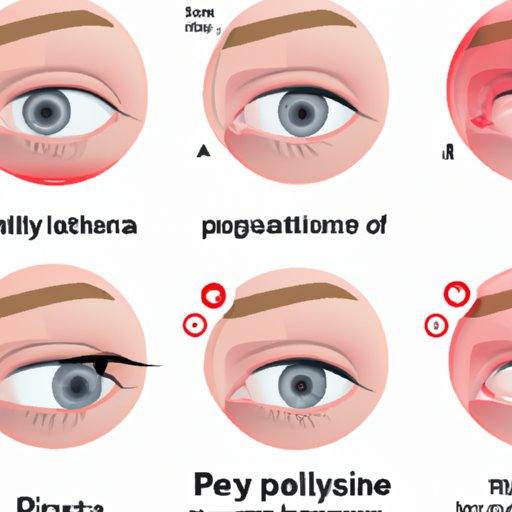
Introduction
Pink eye, also known as conjunctivitis, is an inflammation or infection of the thin, clear tissue that lines the inner surface of the eyelid and covers the white part of the eye. This condition is a common eye problem that can affect anyone, but it is most prevalent in children and older adults.
It is vital to identify the symptoms, causes, risks, prevention methods, and treatments of pink eye to prevent complications and protect your vision. This article provides an overview of how to know if you have pink eye.
Symptoms
Common symptoms of pink eye include:
- Redness in the white of the eye or inner eyelid
- Itchiness or burning sensation in the eye
- Tearing or watery discharge from the eye
- Swollen eyelids
- Sensitivity to light
- Blurred vision
Note that some symptoms of pink eye, such as redness, itching, and tearing in the eyes, can also be caused by other eye conditions such as allergies, dry eye syndrome, or bacterial or viral infections. Therefore, it is crucial to distinguish the symptoms of pink eye from other eye conditions.
If you are experiencing any of the symptoms mentioned above, it is essential to identify them early and seek medical attention. Pink eye can be caused by different things, and seeking the right treatment for your condition is vital to prevent complications.
Causes
Pink eye can be caused by bacterial, viral, and allergic reactions or exposure to irritants such as smoke and chemical fumes. The different types of pink eye include:
- Bacterial pink eye: This is an infection caused by bacteria, such as staphylococcus or streptococcus, that can cause inflammation and pus discharge from the eyes.
- Viral pink eye: This is a highly contagious condition caused by a viral infection, such as the common cold or flu, that can cause watery discharge from the eyes.
- Allergic pink eye: This is an inflammation caused by an allergic reaction to substances such as pollen, animal dander, or dust mites.
If you suspect you have pink eye, it is vital to identify the cause to get the appropriate treatment. Some pink eyes, such as bacterial pink eye, require antibiotics for treatment. Other types, such as viral pink eye, will resolve on their own without medical treatment.
Risk Factors
Several factors can increase your risk of developing pink eye:
- A weak immune system
- Living or working in environments with high exposure to irritants or pollutants
- Sharing towels or pillows with someone who has pink eye
- Not washing your hands regularly
- Having chronic allergies or respiratory conditions
- Wearing contact lenses for an extended period
You can decrease your risk of getting pink eye by adopting good hygienic practices such as washing your hands regularly, avoiding touching your eyes and sharing personal items such as towels and pillows.
Prevention
Prevention is key to avoid getting pink eye. Several measures can help prevent pink eye:
- Washing your hands regularly and using hand sanitizer when handwashing is not possible
- Avoiding touching your eyes with your hands
- Wearing protective eyewear in environments with high exposure to irritants or pollutants
- Cleaning and sanitizing surfaces and personal items such as towels and pillows before use
- Practicing good contact lens hygiene, such as washing your hands before touching the lenses, storing them properly, and replacing them as recommended
It is crucial to maintain good eye health habits to help prevent pink eye and other eye conditions. These include getting regular eye exams, avoiding rubbing your eyes, and ensuring proper nutrition by consuming foods rich in vitamin A.
Treatment
The treatment for pink eye depends on the cause of the condition. Home remedies such as warm compresses and over-the-counter medications such as eye drops can help alleviate mild symptoms of pink eye. However, severe or chronic pink eye requires professional medical attention. Treatment options include:
- Prescription antibiotic eye drops or ointments for bacterial pink eye
- Antiviral medication for viral pink eye
- Prescription allergy medication for allergic pink eye
If you suspect you have pink eye, seek medical attention promptly. Delaying treatment can lead to complications and vision loss.
Conclusion
In conclusion, pink eye is a common eye condition that can affect anyone. The symptoms of pink eye can be confused with other eye conditions, making it crucial to identify them correctly and seek medical attention promptly. Understanding the causes, risk factors, prevention methods, and treatment options for pink eye can help prevent complications and protect your vision. It is also important to maintain good eye health habits to prevent the onset of pink eye and other eye conditions.
Remember, if you suspect you have pink eye, seek prompt medical attention to avoid complications and ensure a speedy recovery.





